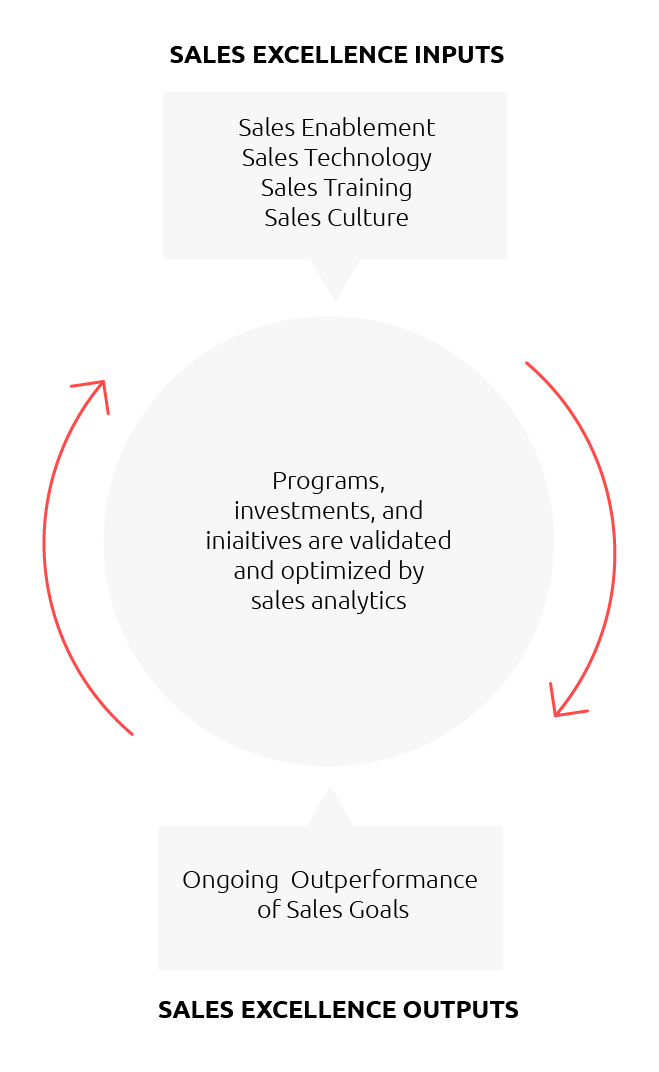Many in the business world would agree. Desire for continuous outperformance is an imperative of any fast-growing company. But like the great athletes of our age, modern leaders know growth doesn’t come from pure luck. Excellence starts behind the scenes.
In this guide, we’re pulling back the curtain to show you what goes into defining, achieving, and maintaining sales excellence and will answer such questions as:

What Is Sales Excellence?
Sales excellence is defined as the consistent outperformance of key growth objectives, achieved by strategic, cross-functional initiatives. These initiatives are key inputs of your revenue engine: your sales coaching and training, tools, enablement, and culture. Together, these factors create an environment that builds and supports high-performing sellers, thus delivering sales excellence.
How you develop each factor is dependent on your business, industry, and goals. Just as a ballerina’s peak performance looks vastly different from a quarterback’s, your version of “excellence” might vary from that of your peers — and even your competitors. However, there are shared methods of measuring your outputs to determine whether or not you’ve achieved sales excellence. We’ll address that next.
How Do You Measure Sales Excellence?
You can measure sales excellence with existing sales analytics by focusing on:
- Sales performance
- Sales productivity
- Sales proficiency
The key performance indicators (KPI) within each category will vary based on your business objectives. However, recent research on the preferred sales metrics of leading businesses offer a starting point. In each category, here are the top five most-tracked metrics:
| Sales Performance | Sales Productivity | Sales Proficiency |
|---|---|---|
|
|
|
The performance, productivity, and proficiency data from this table can reveal whether or not you have achieved sales excellence by demonstrating, first, if sales is achieving its objectives and, second, exactly how that’s happening and who is contributing.
If sales is regularly closing deals and meeting or exceeding your goals, it’s clear you have the processes and programs in place to achieve sales excellence. In this case, the next step is to determine how to keep raising the bar.
However, if you find that your salesforce consistently fails to meet targets, then granular metrics, such as the ones above, will help uncover roadblocks and enable you to resolve them.
How Do You Achieve Sales Excellence?
Sales excellence is achieved through the right combination of processes and programs including:
- Sales enablement
- Sales technology
- Sales culture
- Sales training / coaching
This is because the tools and processes will set you on the path to achieving sales excellence. Let’s take a closer look at how to optimise each of these elements.
1. Expand Your Sales Enablement Use Cases
Why It Matters
Sales enablement is responsible for enabling revenue teams to easily and effectively bring your products to market.
How to Optimise
Start by understanding the sales enablement maturity model. The five stages — ad hoc, reactive, managed, data-driven, and optimised — show an evolution of sales enablement processes and areas of responsibility. Most companies fall somewhere between reactive and managed. That’s because businesses often invest in sales enablement solutions for a specific need (like content management) and fail to fully close the gap between content, rep comprehension, and action.
You can dramatically improve your sales performance by maximising solution use cases. Once early-stage needs like content are met, consider your training and onboarding experiences — do these essential pieces of guidance live within your enablement platform? What about your sales communications or competitive research? Or your sales methodology?
For optimised enablement, integrate these elements into the same platform reps already rely on for content. Once in place, you can measure the closed-loop impact of your enablement initiatives, continue to optimise them, and fully deliver sales excellence.
2. Invest Wisely in New Sales Technology
Why It Matters
The right sales technology can win back valuable time, streamline sales processes, and deliver powerful analytics to inform your sales strategy.
How to Optimise
Tech-stack bloat is a real concern. With so many options to choose from, it can be difficult to know which tools to invest in and which to skip.
Start by covering your bases. Core components of a tech stack include include customer relationship management (CRM), business intelligence, sales enablement, sales engagement, and sales readiness. These five tools form a data-driven ecosystem that enhance reps’ workflow and improve sales operations.
Future investments will likely be in the following categories: account-based sales and marketing strategy, communications/conferencing, performance management, market intelligence, lead generation, and contract management. These strategic additions should either increase sales efficiency or effectiveness — the twin pillars of growing sales productivity.
You can determine where to invest by analysing roadblocks in your customer journey or sales cycle. Interview reps and see where deals stall out or why they’re struggling to meet quota. If for instance, sales struggles to efficiently researching customers, a market intelligence platform might be the next step. Or, if your deals are delayed due to proposal generation or signature processing, perhaps you’re ready for a contract management solution.
However you build your tech stack, be sure that each investment adds value — and never shy away from upgrading solutions that don’t scale with you.
3. Commit to Continuous Sales Training
Why It Matters
Ongoing training prepares reps with the knowledge of what to know, say, show, and do for every customer conversation.
How to Optimise
To maximise the impact of sales training and coaching, several mechanisms must be in place. As mentioned earlier, training materials must be integrated with your sales enablement platform. By providing guidance and additional resources inline with sales content, sales professionals can easily access the materials they need to prepare, when they need them — before critical customer conversations.
Additionally, training must be a continuous process. Materials should be updated frequently and rep proficiency measured often. Doing so ensures both content and reps stay fresh on product offerings, key messaging, and industry trends.
Finally, you must invest in coaching. Not only does this mean preparing reps through role play scenarios, call reviews, and one-on-one mentoring, but also by ensuring sales managers have been trained on key sales skills. After all, the guidance sales leaders deliver will only be as strong as your investment in their growth.
By building a robust sales training program, you’ll not only enable reps to navigate customer engagements, but empower them to grow throughout the course of their tenure at your business.
4. Build a Supportive Sales Culture
Why It Matters
Good sales culture enables reps to do great work and ensures their long-term loyalty.
Begin by building a tight relationship with human resources. This function can provide additional support and resources as you implement culture initiatives.
Once your teams are aligned, take measure of your current sales organisation and culture. Ideally, you have fostered a welcoming, learn-it-all environment that enhances employees strengths and helps them overcome weakness. Surveys, one-on-one conversations, and observations are all effective ways of checking your culture’s pulse.
Ask yourself — where are your areas of growth? Do employees feel like they can make mistakes? Do they feel empowered to take initiative, or are they process-bound? Does your compensation model encourage ethical behaviour? Do salespeople feel incentivised to stay and if so, why?
The answers to these questions will reveal whether or not your culture helps or hinders sales excellence. Initiatives, such as mentorship programs, team happy hours, employee recognition, and diversity and inclusion investments, can all move your culture in the right direction and ensure salespeople can perform at their best.
Maintaining a State of Sales Excellence
Use this guide to start operationalising your sales excellence initiatives. By maximising your sales excellence inputs (processes, tools, people, and culture) and validating them with data (performance, proficiency, and productivity metrics), you can not only achieve sales excellence — but sustain it over the long-term.
Ready to get started? Explore our guide to optimising revenue team enablement.




